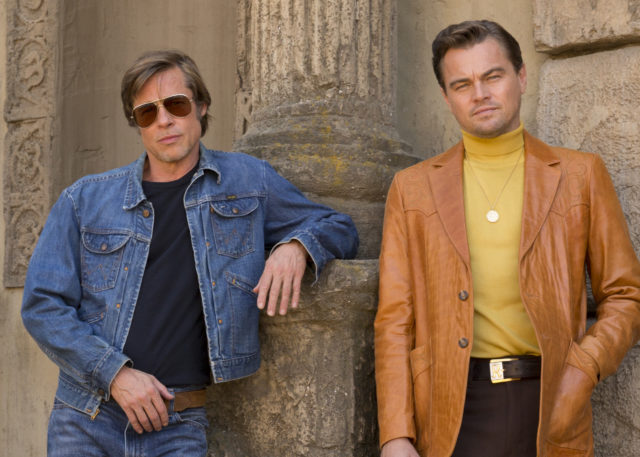
Once Upon a Time in … Hollywood
NEW YORK — Any film linking the names of writer-director Quentin Tarantino and infamous cult leader Charles Manson is unlikely to be a peaceable affair. And this eventually proves true for the auteur’s ruefully affectionate look back at 1969 Tinseltown, “Once Upon a Time in … Hollywood” (Columbia).
Things begin thoughtfully enough as Tarantino uses two fictional characters — Rick Dalton (Leonardo DiCaprio), a screen star who’s experiencing a career crisis, and his stunt man and best pal, Cliff Booth (Brad Pitt) — to explore the milieu of the time and setting.
With Dalton’s prospects on the wane, Booth is busier as his chauffeur and handyman than doubling for him on screen. Yet their macho, beer-and-a-pizza bromance endures.
Menace underlies Tarantino’s pitch-perfect evocation of the era as both one of Manson’s (Damon Herriman) followers, nicknamed Pussycat (Margaret Qualley), and his group’s most famous future victim, actress Sharon Tate (Margot Robbie), cross paths with the duo. Tate and her husband, director Roman Polanski (Rafal Zawierucha), have recently moved in next door to Dalton.
Booth tangles with Manson’s “family” after giving hitchhiker Pussycat a lift home to the Spahn Ranch, a former movie set for Westerns where he and Dalton both once worked. Pussycat’s version of flirting, it develops during their ride together, includes casually offering to perform an aberrant sex act on Booth.
Al Pacino has a ball as Marvin Schwarzs, a quintessential industry insider who hopes to revive Dalton’s career by helping him get cast in a spaghetti Western. And Tarantino gives tough-guy Booth the chance to tussle with legendary martial artist Bruce Lee (Mike Moh).
Though diffuse and somewhat self-indulgent, the film ultimately achieves a powerful cumulative effect aesthetically. The script’s reflections on friendship, the link between fiction and reality and life as an actor and/or celebrity all resonate. Tarantino’s careful craftsmanship even extends to the title, which both invokes Sergio Leone’s “Once Upon a Time in the West” (1968) and correctly labels the tale he’s telling as a fable.
Yet, in line with other of Tarantino’s recent offerings, the movie wallows, briefly but excessively, in brutal, gruesome violence visited on easy-to-hate victims. It thus appeals to viewers’ worst instincts even as it ostensibly condemns the real-life effects of ecstatically sadistic entertainment.
The film contains skewed values, a sequence of horrific, torturous mayhem, some other violence, drug use, frequent profanity, a few milder oaths, pervasive rough and crude language and explicit sexual references. The Catholic News Service classification is O — morally offensive. The Motion Picture Association of America rating is R — restricted. Under 17 requires accompanying parent or adult guardian.
Fast & Furious Presents: Hobbs & Shaw
NEW YORK — In keeping with a tested formula, barbs are traded, vehicles are raced and both fists and bullets fly in “Fast & Furious Presents: Hobbs & Shaw” (Universal), director David Leitch‘s stand-alone addition to the popular action franchise that started in 2001.
The result is mayhem aplenty, which is also, of course, part of the recipe. Still, the absence of gore, together with an implicitly pro-life message and themes of family unity and forgiveness make this rowdy globetrotting chase acceptable for most grown viewers.
As fans of the series will know, and others will quickly discover, the insults aforementioned are part of the longtime antagonism shared by the characters of the title, Dwayne Johnson’s Luke Hobbs, a retired American law-enforcement official, and Jason Statham’s Deckard Shaw, a British military veteran. The premise here is to force the two into partnership and watch the sparks fly.
To achieve that, screenwriters Chris Morgan and Drew Pearce get Shaw’s estranged sister, Hattie (Vanessa Kirby), an intelligence operative for MI6, mixed up in a plot to use a newly developed bioweapon to launch a global pandemic.
As part of a team that tries but fails to secure the substance, Hattie is forced to take possession of it by injecting the capsules containing it into her own body. Whereupon she is promptly accused of going rogue and stealing the stuff, so she goes on the lam.
By the time her brother and Luke catch up with her, Hattie has less than 72 hours before the containers will dissolve, at which point she will die, and the disease will be off to the races. Though she expresses her willingness to sacrifice herself rather than endanger a whole swath of the world’s population, Hobbs and Shaw insist there’s another way.
The virus was developed by Eteon, a secretive organization intent on killing off the weak and enhancing survivors — as they have already done with Brixton Lorr (Idris Elba), the seemingly unstoppable cyber-soldier they dispatch to retrieve the toxin. The main trio’s quest to thwart Eteon’s plan takes them from London to Moscow and eventually on to Hobbs’ homeland, Samoa.
Amidst the car chases and pyrotechnics, Shaw and Hattie try to work through the misunderstanding that has separated them, even as new tensions arise based on the mutual attraction she and Hobbs are experiencing. Once we reach the Pacific, Hobbs has the opportunity to mend similar fences with his alienated sibling, Jonah (Cliff Curtis).
Thus, although a brief invocation of the native gods of Samoa takes the place of the subtle Catholic trimmings that have sometime appeared in earlier installments, the values underlying the script, including the emphatic dismissal of Eteon’s criminal lunacy, will be found congenial by moviegoers of faith. Traffic cops, by contrast, may be outraged.
The film contains constant harsh but bloodless violence, including gunplay, explosions and torture, some sexual humor, a few uses of profanity, at least one rough term and much crude and crass language. The Catholic News Service classification is A-III — adults. The Motion Picture Association of America rating is PG-13 — parents strongly cautioned. Some material may be inappropriate for children under 13.
Mulderig is on the staff of Catholic News Service.








